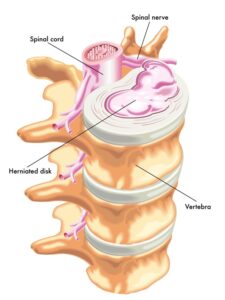Tens of millions of people across the world suffer from pain caused by compression or irritation of the sciatic nerve – the longest in the human body, starting in the lumbar area and going all the way over the thigh and calf areas down to the foot. In the U.S. alone, people are spending upwards of $86 billion on spine treatments, cost that has gone up 65 percent in less than a decade, coming close to the amount spent by cancer patients on therapy and treatment.
The National Institute of Health estimates that roughly 4 in 5 Americans (80% of the entire U.S. population) will suffer from disabling low back at some point during their lifetime. And yet, despite the growing numbers of back pain and sciatica sufferers, few people know the truth about sciatica pain, symptoms, and treatment. Some believe sciatica is a hereditary disease that is only caused by a herniated disc, while others are confident there is no other remedy for sciatica pain except for invasive surgery and complete bed rest.
The good news is, none of these statements is true, but unfortunately, myths about sciatica pain have spread like wildfire in recent years, oftentimes preventing sufferers from reporting symptoms and receiving adequate care. Here are the top five sciatica misconceptions:
1. Sciatica is a disease.
Sciatica is not a disease on its own, but a set of symptoms that manifest themselves in various ways. The most common causes of sciatica include compression of spinal nerves L3-L5 or compression/irritation of the sciatic nerve, and the pain is typically felt on one side of the body starting from the lower back to the buttocks, thighs, calves, and directly to the foot. The pain and associated numbness, tingling, or irritation reported by sciatica sufferers in the leg and buttocks areas are only radiating, meaning they have nothing to do with those locations at all.
2. Sciatica is genetic.
 No, sciatica is not hereditary – it doesn’t run in the family and can occur to anyone regardless of their family health history. It is most commonly a result of a herniated disc directly pressing on the sciatic nerve. The cause of this pressure is in the structural degeneration of the intervertebral disc as a result of bad posture, incorrect flexing forward, giving birth, heavy lifting, tension of the muscles, inflammation of the sacroiliac joint, difference in the length of legs, arthritis, arthrosis, and several others spinal disorder, including spinal tumors, piriformis syndrome, lumbar spinal stenosis, spondylolisthesis, and trauma.
No, sciatica is not hereditary – it doesn’t run in the family and can occur to anyone regardless of their family health history. It is most commonly a result of a herniated disc directly pressing on the sciatic nerve. The cause of this pressure is in the structural degeneration of the intervertebral disc as a result of bad posture, incorrect flexing forward, giving birth, heavy lifting, tension of the muscles, inflammation of the sacroiliac joint, difference in the length of legs, arthritis, arthrosis, and several others spinal disorder, including spinal tumors, piriformis syndrome, lumbar spinal stenosis, spondylolisthesis, and trauma.
3. Leg pain without back pain rules out sciatica.
Wrong again. Sciatica manifest itself differently for every individual, and symptoms may widely vary depending on the location of the irritated nerve. For some, the pain – mild or acute – may remain in their lumbar area, while others may experience tingling and numbness in their leg without having any low back pain. Even more so, sciatica symptoms may appear directly in the feet and toes, as a prickly feeling or burning sensation. It typically affects one side of the body, but it may be possible for a sufferer to report pain on both sides. The severity and duration of symptoms will also differ from person to person.
4. Complete bed rest is effective for sciatica.
Bed rest may be effective for a few days, if the pain becomes too excruciating, but prolonged inactivity will only worsen the symptoms. Usually recommended for decreasing muscle spasms, bed rest means limited mobility, preventing the spine from receiving and transporting nutrients and fluids within vertebral discs. Prolonged rest will also lead to loss of strength in the muscles and a decreased ability to support the spine and back.
5. Sciatica is incurable.
 Not only is sciatica perfectly curable, but many patients recover from it without receiving any treatment. Most sufferers prefer non-surgical methods to relieve the pain caused by spinal compression, and most common therapies include heat and ice therapy, lumbar disc decompression, pain medication, physical therapy, epidural steroid injections, massage therapy, and acupuncture. Recurring sciatica pain that doesn’t go away with non-invasive methods is usually treated surgically, especially in patients at risk of muscle damage or those who have experienced significant loss of function.
Not only is sciatica perfectly curable, but many patients recover from it without receiving any treatment. Most sufferers prefer non-surgical methods to relieve the pain caused by spinal compression, and most common therapies include heat and ice therapy, lumbar disc decompression, pain medication, physical therapy, epidural steroid injections, massage therapy, and acupuncture. Recurring sciatica pain that doesn’t go away with non-invasive methods is usually treated surgically, especially in patients at risk of muscle damage or those who have experienced significant loss of function.
Chiropractic care is the preferred treatment method for sciatica pain not just because it’s 100% natural and provides immediate pain relief, but most importantly because the results are permanent. Through innovative and effective therapies, including ice/cold therapy, ultrasound, spinal manipulation, and nerve stimulation, your therapist may greatly reduce nerve irritation, pain, and inflammation by correcting the spinal misalignment. Pain should not be a lifestyle – contact your local chiropractic office if you experience any of the symptoms associated with sciatica.
About the Author
Dr. Marc Browner practices at Windmill Health Center in Weston, Florida. A graduate of the University of Florida, he earned his Doctor of Chiropractic degree in 1995. In private practice since 1998, Dr. Browner is a member of the Florida Chiropractic Society, the Florida Chiropractic Association, and he attends continuing education seminars, classes, and workshops to remain abreast of the most current treatment methods and technological advances in the field.


